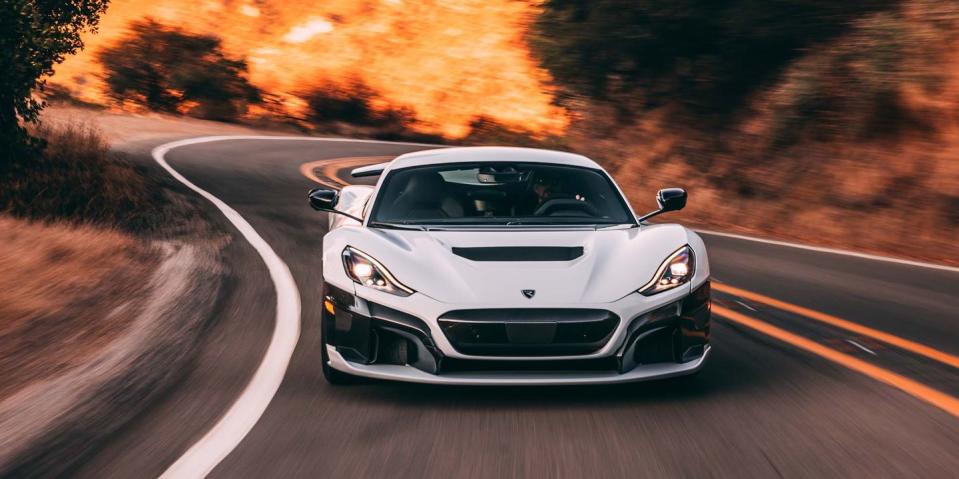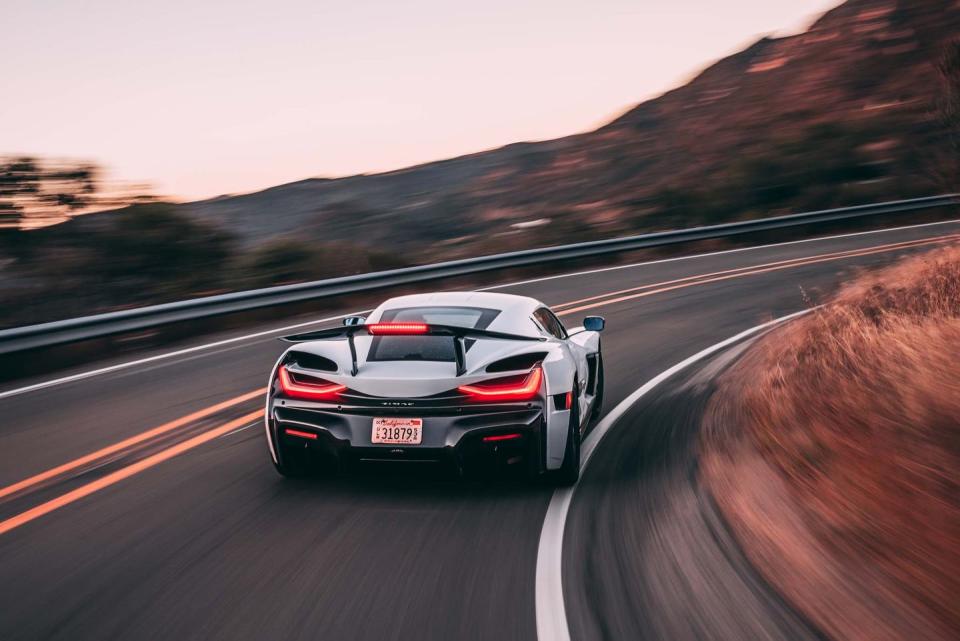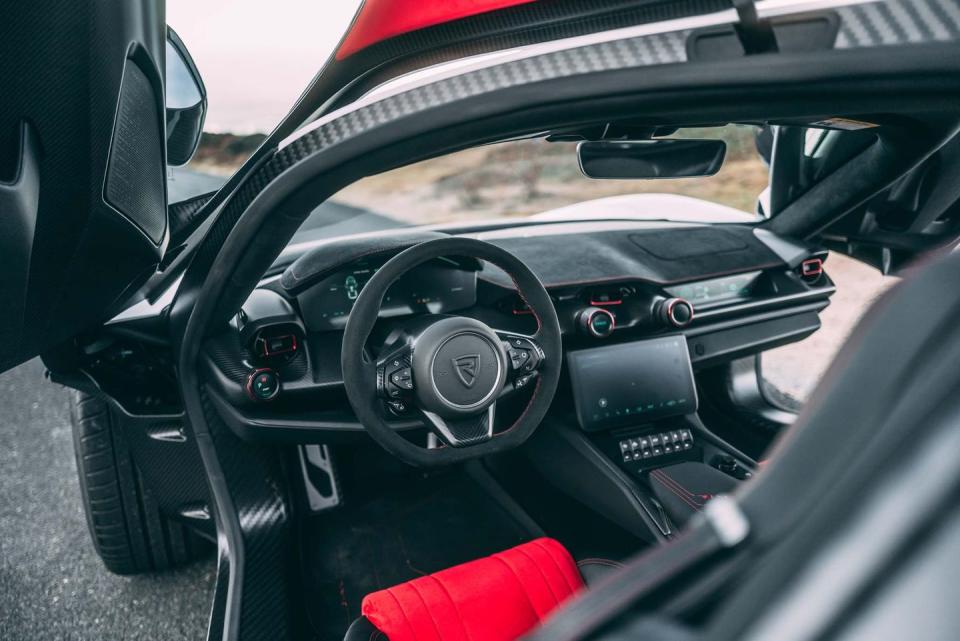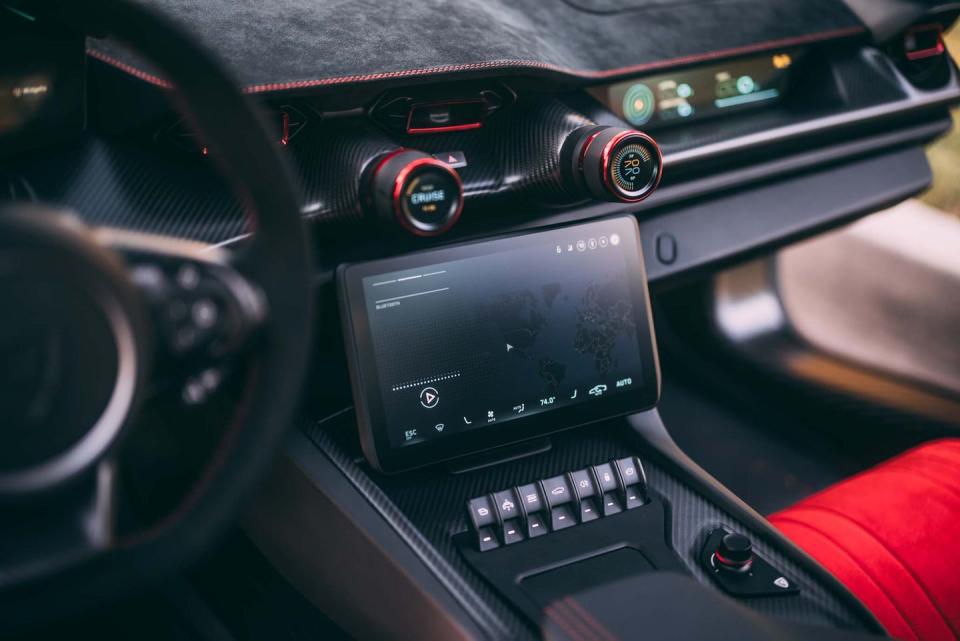2022 Rimac Nevera Hypercar Is Alive

We don't know exactly what we were expecting, but the 2022 Rimac Nevera is definitely not an antiseptic EV that lacks a soul. We slid in, and the faint rumble of the climate-control system made a reasonable impression of an idling engine. Was this intentional? It's unclear, but it worked for us. As we got underway, the whine of the four motors and their attendant reduction gears gave off an impression that the thing was alive—no need for the synthetic space-commander theme music you find in a Porsche Taycan or a BMW i4. The motor sounds coming from all four corners through the carbon-fiber conduit that is the Rimac's one-piece chassis connected us to the machine like no other EV has.
The Nevera brings an almost-preposterous 1813 horsepower to bear via a quad-motor propulsion system that assigns one carbon-sleeved permanent-magnet AC synchronous motor and direct-drive transmission to each wheel. (That figure is slightly less than the peak output we've reported before, as engineers on-site at the drive event confirmed that 1877 hp is the battery's maximum output, but 1813 hp is the maximum that can make it to the motors.) The car's total output at full whack is naturally rear biased, because while each front motor is rated at 295 hp and 207 lb-ft, the two rear drive units are good for a monster 644 horses and 664 lb-ft apiece. The Nevera is said to be capable of a 1.85-second leap to 60 mph and a quarter-mile time of 8.6 seconds. Those numbers were earned on a prepped drag strip, but we don't think they're too far off what we might measure when we get the chance. Rimac also claims a top speed of 258 mph.

The actual output can be tailored through the five drive modes. Range mode makes use of 100 percent of the front-motor torque while limiting rear-motor torque to 30 percent of maximum. Because of the wildly different torque output available at each end, that works out to a near 50/50 split from the pavement's point of view. In practice, though, we rarely saw the rear power meter light up while we cruised in Range, giving us the impression that this mode is more heavily front biased than all of that math suggests. And the Nevera needs all the range help it can get, as the EPA methodology gives it a stingy 205-mile range figure.
Cruise and Sport modes cap front and rear output at 70 percent of their respective limits. The difference between these two modes amounts to steering assist and the damping profile of the electronically adjustable KW-supplied dampers. Track mode cranks both of those parameters up another notch, but importantly, it also lets go of the reins so the motors at each end can deliver up to 100 percent of their rated maximums. Then there's Drift mode, which puts the front motors to bed while allowing the driver to light the rears up to 100 percent of their potential.

Rimac is rightfully very proud of the advanced torque vectoring this quad-motor powertrain has facilitated, but we found it wanting in Cruise and Sport modes, where its ability to read the road and make instantaneous decisions about available grip seemed less refined than our own eyeballs and local knowledge. Caution and a conservative approach are of course appreciated with the ruinous potential of 1800-plus horsepower on tap. But it didn't take much to get the system to balk at attempts to put the power down in corner-exit situations that a Hyundai Veloster N would have agreed to enthusiastically. Things only seemed to come right when we dialed in Track mode, which allowed us to roll into the accelerator as intended because of its more aggressive torque-vectoring map and more permissive traction control.
Thankfully, beside the above five default modes, there are two other customizable ones. We'd use them to modify the Cruise and Sport settings to have the Track mode's torque vectoring and traction-control permissiveness. Frankly, though, it'd be nice if the car weren't quite so stingy, particularly in Sport mode.

The chassis, on the other hand, is otherworldly. The rigidity of its carbon-fiber structure is immense, and the front and rear control-arm suspensions bolt directly to it. The only appendages are the front and rear crash structures that support the bodywork. Additional chassis strength comes from the massive 117.0-kWh T-shaped battery pack, a fully stressed chassis member that runs between and behind the seats and seatbacks, with additional wings of cells spreading out under each occupant's feet, but not under their seats. The absence of cells under the seat allows for a low seating position that makes a supercar roofline possible.

 Yahoo Autos
Yahoo Autos 